Population
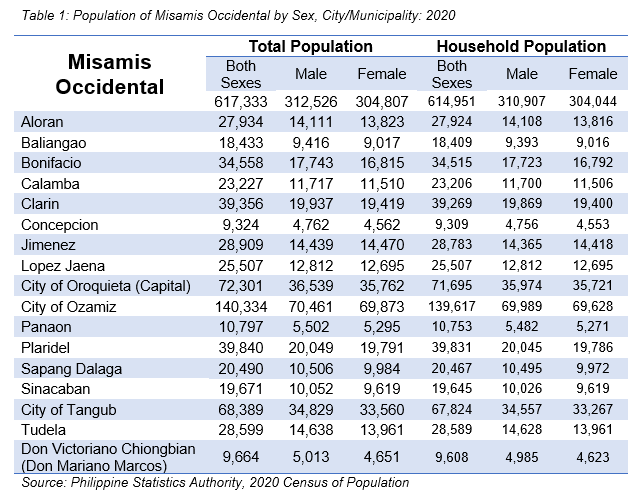
According to the 2020 Census of Population and Housing (2020 CPH), Misamis Occidental recorded a total population of 617,333 individuals, an increase from 602,126 individuals in 2015. Among this population, 312,526 individuals (50.63%) were male, while 304,807 individuals (49.37%) were female.
The city of Ozamiz emerged as the most populous, hosting 140,334 individuals, with 70,461 (50.21%) males and 69,873 (49.79%) females. In contrast, the municipality of Concepcion exhibited the lowest population count at 9,324 individuals, comprising 4,762 males (51.07%) and 4,562 females (48.93%).
Additionally, the household population of Misamis Occidental stood at 614,951 individuals, with 310,907 males (50.56%) and 304,044 females (49.44%). (Refer to Table 1.)
Age and Sex Distribution
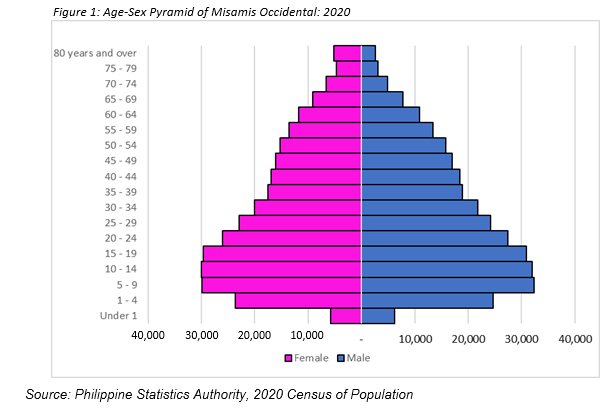
In terms of age distribution, 184,680 individuals (29.92%) fell into the category of under 15 years of age, classified as young dependents, comprising 95,319 males and 89,361 females. On the other hand, individuals aged 15 to 64 years, considered the working-age or economically-active population, totaled 388,714 (62.97%), while those aged 65 years and older, categorized as old dependents, constituted 43,939 individuals (7.12%).
Notably, within the 0 to 54 age group, there was a higher number of males (269,826) compared to females (253,974). However, among individuals aged 55 years and older, females (50,833) surpassed males (42,700) in number. (Refer to Figure 1).
The sex ratio, calculated at 103, indicates that there were 103 males for every 100 females within the total population. This ratio progressively declined with age, with a decrease in the number of males, resulting in females outnumbering males in the older age groups. (Refer to Figure 2 and Table 2).
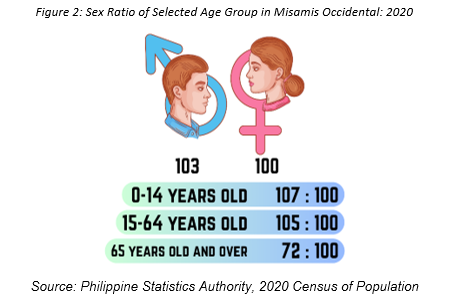
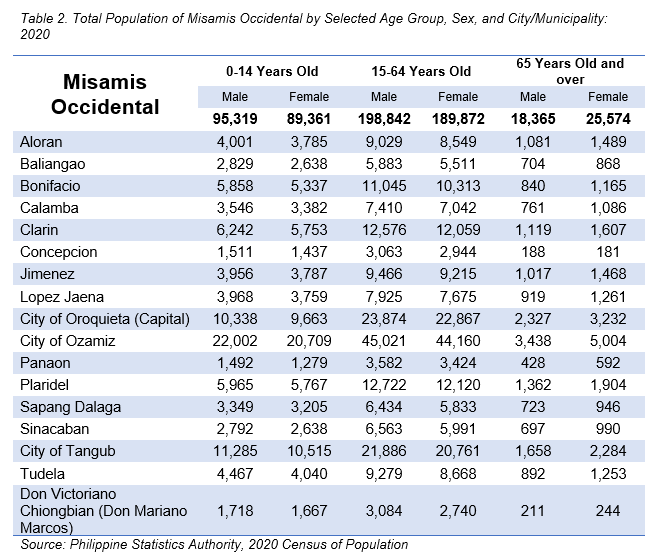
Marital Status
Marital status among individuals aged 10 years and above within the total population, categorized by sex. Among males, 105,803 individuals are single, while 86,801 females fall into the same status. In terms of marriage, 100,223 males are married compared to 99,531 females. Additionally, there are 32,485 males and 32,401 females in common-law or live-in relationships. Notably, the number of widowed individuals shows a significant gender disparity, with 6,648 males and 21,169 females. Similarly, in the separated/divorced/annulled category, there are 4,093 males and 5,555 females. A small number of individuals have an unknown marital status, with 8 males and 19 females. (Refer to Table 3)

Registered Births
Total count of births recorded was 606,984 or 98.70 percent of the household population. Among these births, 306,840 are male, while 300,144 are female. (Refer to Figure 3)
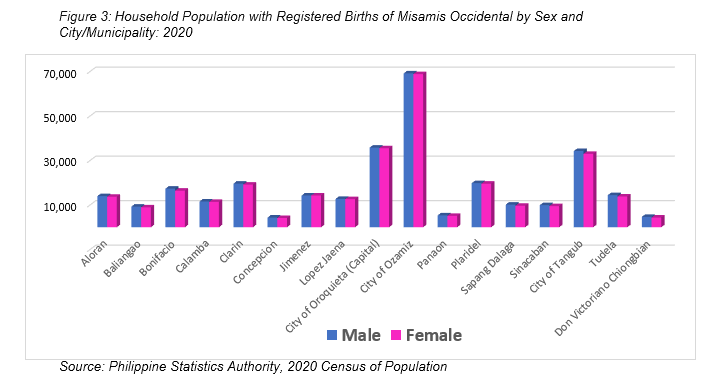
Literacy
Literate was defined as being able to read and write, and based on the 2020 CPH, 539,646, or 97.30 percent, of the household population aged 5 years and over was literate, consisting of 271,979 males and 267,667 females. (Refer to Figure 4)
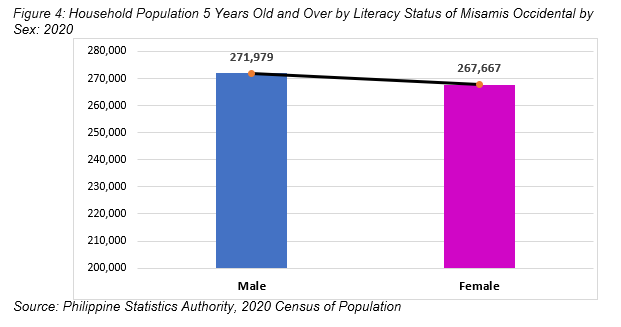
Highest Grade Completed
The 2020 CPH gave an overview of the highest grades completed among males and females. Among the household population aged 5 years and over, 280,017 males and 274,610 females were accounted for in various highest-grade completed categories.
Among males, 4,606 had not completed any grade, while the corresponding figure for females stood at 4,136. Additionally, 7,944 males and 7,154 females had received early childhood education. In terms of elementary education, there were 93,831 males and 77,498 females, indicating a notable difference between genders. However, the trend shifted in high school education, with 105,909 males compared to 107,315 females.
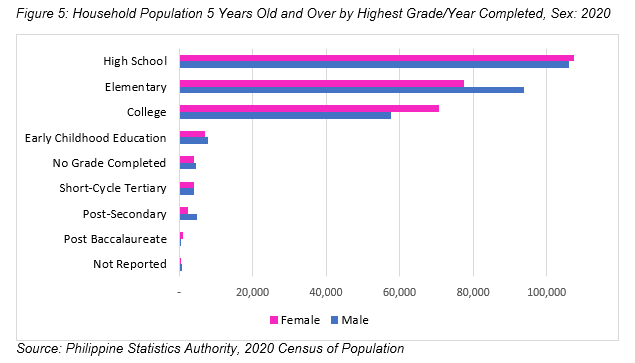
Moving on to higher education, 4,913 males and 2,511 females pursued post-secondary education, while 3,935 males and 3,964 females opted for short-cycle tertiary education. The data also revealed gender disparities in college education, with 57,582 males and 70,574 females attaining this level of education.
Furthermore, a small number of individuals pursued post-baccalaureate studies, with 592 males and 1,007 females. Lastly, 705 males and 451 females did not report their educational status. (Refer to figure 5)
Functional Difficulty
The domain of functional difficulties experienced by individuals, categorized by sex. Across various domains, including seeing even with eyeglasses, hearing even with a hearing aid, walking or climbing steps, remembering or concentrating, self-caring tasks such as washing all over or dressing, and communicating, differences between males and females are observed.
Specifically, in the domain of visual impairment, 17,644 males and 23,565 females reported challenges with seeing, even while wearing eyeglasses. Similarly, in terms of hearing impairment, 6,380 males and 7,418 females reported difficulties, even when using a hearing aid.
Concerning mobility, 6,019 males and 6,494 females reported challenges with walking or climbing steps. In the cognitive domain, including remembering or concentrating, 4,742 males and 6,674 females reported difficulties. Additionally, in the area of self-care, such as washing all over or dressing, 2,190 males and 2,514 females reported challenges.
Finally, in terms of communication difficulties, 2,151 males and 2,316 females reported challenges in this domain. (Refer to figure 6)
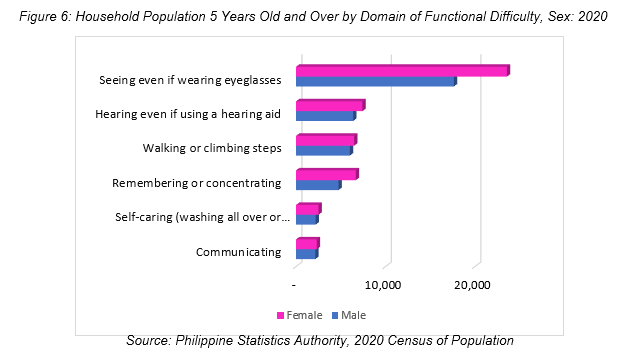
Religious Affiliation
Among the various religious affiliations in Misamis Occidental, 68.15 percent were Roman Catholic, excluding the Catholic Charismatic, with a slightly higher male population of 212,870 is noted compared to 206,221 females. Similarly, the Iglesia Filipina Independiente and the Aglipay affiliation both demonstrate nearly equal sex distributions, with marginal differences between male and female membership counts. In contrast, the Seventh Day Adventist community displays a balanced representation of males (7,946) and females (7,906), indicating parity within the affiliation. The Assemblies of God affiliation shows a slight skew towards female membership, with 6,907 females compared to 6,715 males. Conversely, the Iglesia Ni Cristo affiliation exhibits a slightly higher male membership of 6,210 compared to 5,958 females.

Ethnicity
In Misamis Occidental, the top five ethnicities, along with their respective male and female populations, offer insights into the demographic landscape. At the forefront is the Bisaya/Binisaya ethnic group, comprising a total of 428,712 individuals, with 216,011 males and 212,701 females. Following is the Subanen/Subanon community, with a combined population of 109,917 individuals, including 56,021 males and 53,896 females. The Cebuano ethnicity ranks third in population size, with 52,319 individuals, consisting of 26,442 males and 25,877 females. In fourth place is the Boholano ethnic group, totaling 10,337 individuals, divided into 5,226 males and 5,111 females. Lastly, the Ilonggo community completes the top five ethnicities in Misamis Occidental, with a combined population of 2,165 individuals, encompassing 1,124 males and 1,041 females.
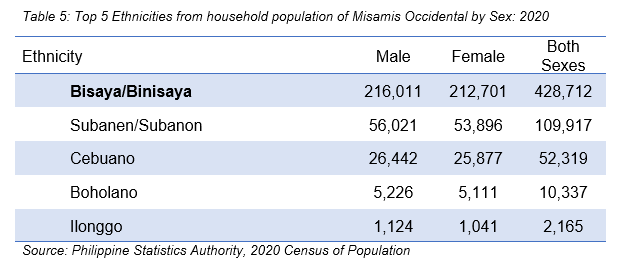
Prepared by:
(SGD)MARK JAE M. VERZOSA
Information Officer I
Approved by:
(SGD)JULIETA M. NACARIO
(Supervising Statistical Specialist)
Officer-In-Charge
Provincial Statistical Office – Misamis Occidental

